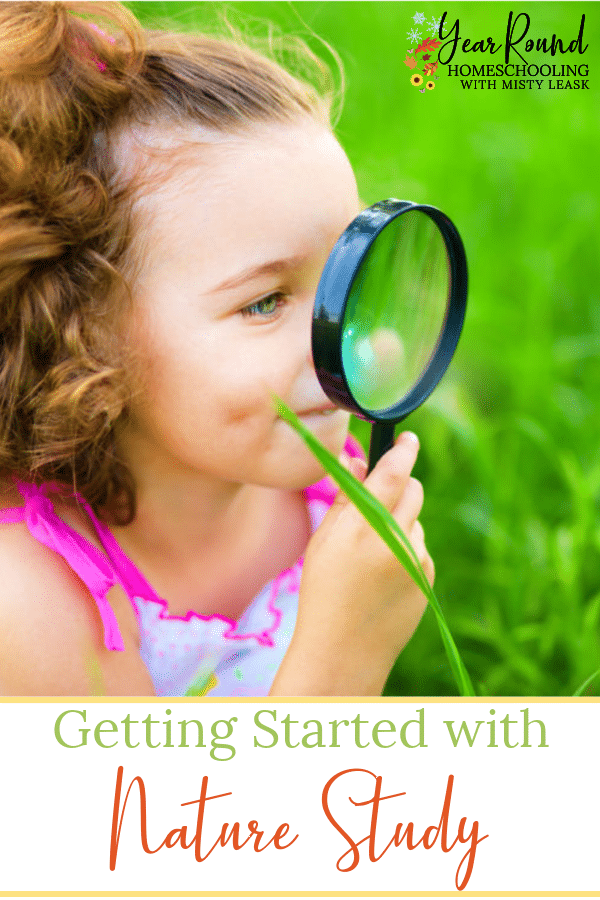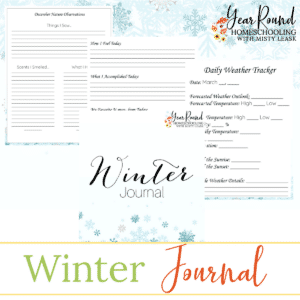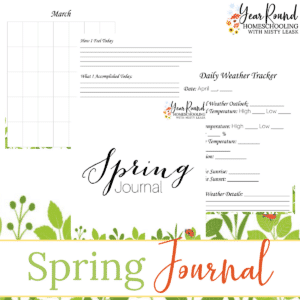Nature study is one of the amazing ways homeschooling can capture your child’s imagination and help your child fall in love with learning. The world has so many fascinating things to offer that you never have to worry about running out of things to do or learn.

If you haven’t done much nature study before, or aren’t sure where to get started, let me share a few things with you that will hopefully make it an easy, fun part of your homeschool schedule.
6 Steps to Getting Started with Nature Study
Work nature study into your day.
The first thing you need to do is schedule some time outside during your day. I know it sounds obvious, but it’s really easy to skip going outside when you start to feel behind in, say, MATH. In fact, studies show that many kids are not spending enough time outside, so it’s good to have it written in your lesson plans.
When planning your day you will want to consider where you live when you’re thinking about the time of day it’s best for you to spend outdoors. This may change from season to season.
You may need to change up your clothing and gear to accommodate different weather conditions. Snow boots can make going out and exploring tracks in the snow easier while a raincoat and books can help you get outside in the rain to see things from a new perspective.
Gather tools to help you with your nature study.
There are a few tools that will make your nature study time easier and more fun, both for you and for your students. As the teacher, it’s your job to learn how to identify what you find and teach your children how to do so, too.
Don’t worry if you’ve never done much of this kind of thing before! It’s never too late to start. Google lens makes looking up plants and animals right on your smartphone easy.
Put together a to-go bag for your students that holds equipment they can use to explore nature. A simple drawstring bag can easily hold a journal, pencils, binoculars, and a magnifying glass to get an up-close look at the things they discover.
Consider getting your child a camera if they do not have a smartphone yet. This is a great way to document what you see while out and about, bring it home for easier scratching into journals or looking up what you found without forgetting details. You can even use a camera to enjoy a scavenger hunt that won’t take anything from nature while you explore.
Check out this fall scavenger hunt pack and Spring scavenger hunt pack, and this beach scavenger hunt pack to make adding scavenger hunts to your nature study or even vacation a breeze.
Get a nature journal.
Getting your child a journal to track the weather, observations in nature, and even practice drawing what they find is a great way to encourage your child to explore, document, and take the time to learn more about the things they discover.
Have your child use these journals to track everything from the sunrise and moon phases to weather patterns. Try not to control these journals too much as they give your child a chance to track what truly interests them. Feel free to encourage them to draw flowers they find at the park or the changes in growth while you work in the garden as part of your homeschool lessons.
Seasonal nature journals are a fun way to have your children learn about the seasons as they are happening. If you use them each year, you’ll have a beautiful set of memories from each year of your child’s homeschooling journey.


Find books to help you on your journey.
When getting started with nature study you will want to gather resources that can help you learn about what you discover and explore areas that you can not visit in person. Your local library is a great way to find books and resources that can become part of your nature study.
Anna Botsford Comstock’s Handbook of Nature Study is a great guide to help you get started. This book is large, and probably not one you’re going to want to carry around with you, but it’s invaluable for any teacher and provides some great lessons on tons of topics. This resource offers wonderful information, with questions you can ask students, but it may be too much to read to your students.
Field guides are another important resource for nature study. I try to take at least one guide with us for whatever we’re currently studying when we go outside. If you don’t have any, they can get expensive, but there are a couple you can get that will help you get started.
Check with your local extension office for resources and guides on local native flora and fauna that you can use as part of your homeschool. Most county extension offices have a large collection of information on everything from native animals to what will grow best in your garden.
Bring your nature study home to your own backyard
Build a weather station. Making your own weather vane and adding in a thermometer and a cylinder with a measuring stick is a great way to dive into your nature study and give your child the tools to explore weather as it happens.
Study the beauty found in spring flowers. Take a trip to your local greenhouse and have your children ask the gardener questions to find the right flowers to create a spring flower garden of their own.
Consider adding a bird feeder or making your own bird feeder to use as part of a backyard bird nature study is a fun way to let your child get an up-close view of birds in your area. Place your bird feeder near a window so that your child can watch the birds while they work inside. You can even find window birdhouses to get a close-up look at birds and their babies.
Try hatching your own butterflies at home as part of a butterfly unit study. This is a fun way to allow your child to observe them up close and personal and learn about being kind to nature when you release your butterflies into the wild. You can find simple kits that make raising butterflies easy.
Go on nature-based field trips
While you can study nature in your own backyard you can really learn a lot with field trips. Go hiking on your local trails, slip down to the beach to study the ocean.
Swing by the zoo to see animals from around the world on a fun and interactive field trip.
Going on vacation? Save money and turn camping into a great chance to do a nature study in a new place.
Visit a site like Falling Fruit to find local foraging spots that can help you find edible plants that are available to the public. This is a great way to explore nature and make a multisensory experience.
Check with your local extension office for lists of places worth visiting from botanical gardens, to hatcheries, and bee sanctuaries
Nature is all around us and it’s part of science. Get outside with your kids and have fun learning and exploring the world around you. Nature study gives your children the opportunity to learn about what they’re studying as it happens!
What is your favorite part of nature study?

